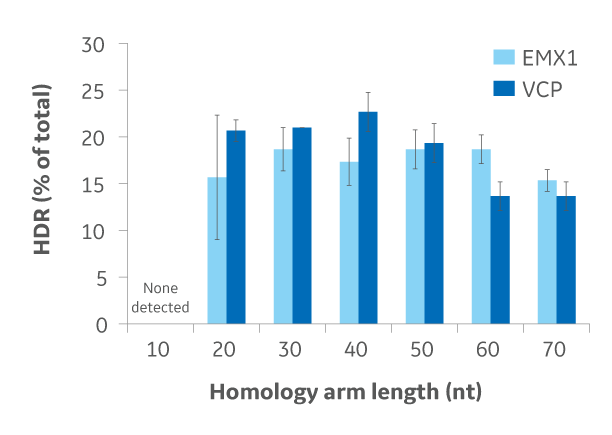Use the HDR Donor Designer to generate a custom ssDNA oligo template for your knock-in experiment!
The CRISPR-Cas9 mechanism utilizes a CRISPR guide RNA and a Cas9 nuclease to specifically target and cleave genomic DNA. Following the creation of a double-strand break (DSB), an endogenous repair mechanism will either repair the break using non-homologous end joining (NHEJ), or in the presence of a single-strand oligonucleotide donor, the break can be repaired and a specific alteration introduced using homology directed repair (HDR). This technique can be used to delete, insert, or replace a region of DNA.
A common problem in carrying out these experiments is in the proper design of a donor oligo. The length and sequence of the homology arms, proper disruption of the Cas9 cleavage site, and distance of the DSB site from the region to be modified are just a few of the key considerations in successful HDR.
The Edit-R HDR Donor Designer greatly speeds and simplifies the process of designing and ordering a donor oligo for precise genome modification. Utilizing an intuitive graphical interface, it allows you to precisely select the exact site for the change at or near the cut site for the guide RNA. If needed, the software will even suggest specific silent mutations to ensure the guide RNA does not continue to cut the DNA following the incorporation of the donor.
If you’ve not yet generated a guide RNA required to make the cut at the desired genomic locus, the CRISPR Design Tool can help you design and select the ideal custom guide RNAs necessary to create the DSB.

Optimizing homology arm length for maximal HDR knockin
Highlights
- Make a precise change in a target gene sequence for human, mouse, or rat
- Donor oligo length of up to 150 bases allows for sequence insertion, removal, or replacement, and symmetric or asymmetric donor oligo configuration
- Intuitive interface lets you accurately design and visualize changes to the gene and the finished DNA template
Start designing your donor today! »
Additional Resources
-
CRISPR-Cas9 Gene Editing - Products
Optimized tools for high-confidence genome engineering -
Homology-directed repair (HDR) with a DNA donor oligo
Considerations for successful HDR experimental design -
CRISPR Design Tool
Design and order a custom crRNA or sgRNA targeting a specific locus in over 30 different genomes
